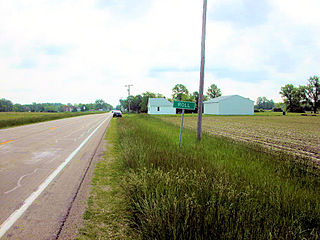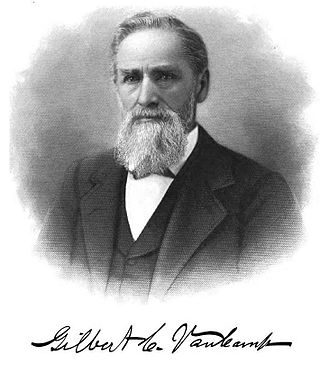
Indianapolis, colloquially known as Indy, is the capital and most populous city of the U.S. state of Indiana and the seat of Marion County. According to the U.S. Census Bureau, the consolidated population of Indianapolis and Marion County was 977,203 in 2020. The "balance" population, which excludes semi-autonomous municipalities in Marion County, was 887,642. It is the 16th-most populous city in the U.S., the third-most populous city in the Midwest after Chicago and Columbus, Ohio, and the fourth-most populous state capital after Phoenix, Arizona, Austin, Texas, and Columbus. The Indianapolis metropolitan area is the 33rd-most populous metropolitan statistical area in the U.S., with 2,111,040 residents. Its combined statistical area ranks 28th, with a population of 2,431,361. Indianapolis covers 368 square miles (950 km2), making it the 18th largest city by land area in the U.S.

Thomas Taggart was an Irish-American politician who was the political boss of the Democratic Party in Indiana for the first quarter of the twentieth century and remained an influential political figure in local, state, and national politics until his death. Taggart was elected auditor of Marion County, Indiana (1886–1894), and mayor of Indianapolis. His mayoral administration supported public improvements, most notably the formation of the city's park and boulevard system. He also served as a member of the Democratic National Committee (1900–1916) and as its chairman (1904–1908). Taggart was appointed to the U.S. Senate in March 1916, but lost the seat in the November election.

The history of Indianapolis spans three centuries. Founded in 1820, the area where the city now stands was originally home to the Lenape. In 1821, a small settlement on the west fork of the White River at the mouth of Fall Creek became the county seat of Marion County, and the state capital of Indiana, effective January 1, 1825. Initially the availability of federal lands for purchase in central Indiana made it attractive to the new settlement; the first European Americans to permanently settle in the area arrived around 1819 or early 1820. In its early years, most of the new arrivals to Indianapolis were Europeans and Americans with European ancestry, but later the city attracted other ethnic groups. The city's growth was encouraged by its geographic location, 2 miles (3.2 km) northwest of the state's geographic center. In addition to its designation as a seat of government, Indianapolis's flat, fertile soil, and central location within Indiana and the Midwest, helped it become an early agricultural center. Its proximity to the White River, which provided power for the town's early mills in the 1820s and 1830s, and the arrival of the railroads, beginning in 1847, established Indianapolis as a manufacturing hub and a transportation center for freight and passenger service. An expanding network of roads, beginning with the early National Road and the Michigan Road, among other routes, connected Indianapolis to other major cities.

William Henry Larrabee was an American physician and politician who served six terms as a U.S. Representative from Indiana from 1931 to 1943.

Indiana Landmarks is America's largest private statewide historic preservation organization. Founded in 1960 as Historic Landmarks Foundation of Indiana by a volunteer group of civic and business leaders led by Indianapolis pharmaceutical executive Eli Lilly, the organization is a private non-governmental organization with nearly 6,000 members and an endowment of over $40-million. The organization simplified its name to Indiana Landmarks in 2010.

Roll is an unincorporated community in Washington Township, Blackford County, in the U.S. state of Indiana. Nearly all of the community's businesses have been closed for years. Although the Blackford County Historical Society lists Roll as a ghost town, homes are still maintained in the area, and it is still listed as a populated place by the U.S. Geological Survey. The rural community is located on Indiana State Road 18, about one mile west of its intersection with Indiana State Road 3.

Edward Everett Cox was an American newspaper publisher who started Blackford County's first daily newspaper in Hartford City, Indiana. He is "considered one of the most influential forces in journalism" in Blackford County, and was a strong supporter of the Democratic Party. Serving as publisher and sometimes as editor of his newspaper, he also spent time as chairman of the eleventh congressional district, county chairman of the Democratic Party, member of the school board, and postmaster. His newspapers were a "voice" for the Democratic Party for nearly 40 years.

Bohlen, Meyer, Gibson and Associates, or BMG, is an architectural firm based in Indianapolis, Indiana. It was founded in Indianapolis on April 10, 1853, as D. A. Bohlen, Architect by Diedrich A. Bohlen, German immigrant. In 1884, after Diedrich's son, Oscar D. Bohlen, joined the firm it was renamed D. A. Bohlen and Son. Four successive generations of Bohlen architects have worked at the firm: Diedrich A. Bohlen, Oscar D. Bohlen, August C. Bohlen, and Robert L. Bohlen. The firm specialized in institutional projects, especially civic, religious, and educational buildings. In 1971 Melvin B. G. Meyer acquired majority interest in the firm, which adopted its name in reference to its founder and its two principal architects, Meyer and John M. Gibson. The architectural firm is among the oldest still operating in the United States. More than twenty of its projects are listed on the National Register of Historic Places.

William Vincent Wheeler (1845–1908) was the founder of Wheeler Mission Ministries of Indianapolis, Indiana.

Charles Elbridge Cox was an American lawyer and judge who became the 55th justice of the Indiana Supreme Court, serving from 1911 to 1917. Elected as a Democrat in the Fall of 1910, he was Chief Justice by the end of his six-year term. The "Marshall Constitution" case and the "Technical Institute" case were among the important decisions made by the court during his tenure. As a judge in the Indiana Supreme Court and in lower courts, he never had a decision reversed.

Shopbell & Company was an American architectural firm located in Evansville, Indiana, in the United States.
The following is a timeline of the history of the city of Indianapolis, Indiana, United States.

Gilbert C. Van Camp was an Indianapolis businessman who founded the Van Camp canning company.
Diedrich Augustus Bohlen a native of Cadenberge, Kingdom of Hanover, immigrated to the United States around 1851 and founded D. A. Bohlen, Architect, in 1853 at Indianapolis, Indiana. In 1971 it became Bohlen, Meyer, Gibson and Associates, and is among the oldest architectural firms in the United States still in operation. Bohlen is best known for introducing the German Neo-Gothic architecture style to Indiana. Bohlen and his firm specialized in institutional projects, especially civic, religious, and educational buildings. More than forty of the firm's projects are listed on the National Register of Historic Places, including several of D. A. Bohlen's designs: Morris-Butler House (1864); Saint John the Evangelist Catholic Church (1871), its rectory (1863), and bishop's residence (1878); Indianapolis's Roberts Park Methodist Church (1876) and Crown Hill Cemetery's Gothic Chapel (1877); and in collaboration with his son, Oscar D. Bohlen, the Indianapolis City Market (1886). The combined campus of Saint Mary-of-the-Woods College and the Sisters of Providence of Saint Mary-of-the-Woods make up the Saint Mary-of-the-Woods Historic District, the largest cohesive collection of Bohlen buildings. The District is of statewide significance on the National Register of Historic Places, for its contribution to architectural, educational and religious history.
Herman Sturm was a prominent military leader and wealthy resident of Indianapolis, Indiana who at one time owned the arsenal property, now the site of the Arsenal Technical Institute. General Sturm had official and personal charge of the arsenal and of the general ordnance affairs of the state as related to the fabrication of ammunition and the care and custody of large quantities of ordnance stores, including small arms, field and heavy ordnance equipment, etc., issued by the state and United States government to over 250,000 troops sent to the field and enrolled in the militia of the state of Indiana, during the American Civil War. At the close of the war, it was found that the arsenal had a large surplus of money, which was turned over to the state treasury.

Zelda Harrison Seguin Wallace was an American opera singer and suffragist.

Addison Clay Harris was a lawyer and civic leader in Indianapolis, Indiana, who served as a Republican member of the Indiana Senate and a U.S. Envoy Extraordinary and Minister Plenipotentiary (ambassador) to Austria-Hungary. The Wayne County, Indiana, native graduated from Northwestern Christian University in 1862 and was admitted to the bar in 1865, the same year he established a law partnership with John T. Dye in Indianapolis. Harris was a founding member (1878) and president of the Indianapolis Bar Association; a founder and president of the Indiana Law School, which was a forerunner to the Indiana University Robert H. McKinney School of Law in Indianapolis; a presidential elector in 1896; president of the Indiana State Bar Association (1904); a member (1905–1916) and president of Purdue University's board of trustees; and a member of the Indiana Historical Society and the Columbia Club.

George Levi Knox II was a U.S. Army Air Force/U.S. Air Force officer, combat fighter pilot and Adjutant with the all-African American 332nd Fighter Group's 100th Fighter Squadron, best known as the Tuskegee Airmen. One of the 1,007 documented Tuskegee Airmen Pilots, he was a member of the Tuskegee Airmen's third-ever aviation cadet class, and one of the first twelve African Americans to become combat fighter pilots. He was the second Indiana native to graduate from the Tuskegee Advanced Flying School (TAFS).
William Lamborn Taylor was an American lawyer and politician who served as the seventeenth Indiana Attorney General from November 18, 1898 to January 1, 1903.
















